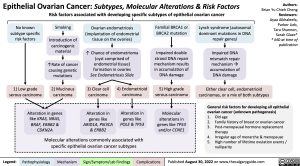Epithelial Ovarian Cancer: Subtypes, Molecular Alterations & Risk Factors Risk factors associated with developing specific subtypes of epithelial ovarian cancer
Authors: Brian Yu Chieh Cheng Reviewers: Ayaa Alkhaleefa, Parker Lieb, Tara Shannon, Sarah Glaze* * MD at time of publication
No known subtype specific risk factors
Smoking
Introduction of carcinogenic material
↑Rate of cancer causing genetic mutations
2) Mucinous carcinoma
Ovarian endometriosis (implantation of endometrial tissue on the ovaries)
↑ Chance of endometrioma (cyst comprised of endometrial tissue) formation in ovaries
See Endometriosis Slide
Familial BRCA1 or BRCA2 mutation
Impaired double strand DNA repair mechanism results in accumulation of DNA damage
5) High grade serous carcinoma
Lynch syndrome (autosomal dominant mutations in DNA repair genes)
Impaired DNA mismatch repair
mechanismà accumulation of DNA damage
1) Low grade serous carcinoma
3) Clear cell carcinoma
4) Endometrioid carcinoma
Either clear cell, endometrioid carcinomas, or a mix of both subtypes
General risk factors for developing all epithelial ovarian cancer (unknown pathogenesis)
1. Old age
2. Family history of breast or ovarian cancer
3. Post-menopausal hormone replacement therapy
4. Irregular age of menarche & menopause 5. High number of lifetime ovulation events /
nulliparity
Alteration in genes like KRAS, NRAS, BRAF, ERBB2 & CDKN2A
Alteration in genes like ARID1A, PIK3CA & ERBB2
Alteration in genes like POLE & TP53
Molecular alterations in genes like TP53 and/or CCNE1
Molecular alterations commonly associated with specific epithelial ovarian cancer subtypes
Legend:
Pathophysiology
Mechanism
Sign/Symptom/Lab Findings
Complications
Published August 30, 2022 on www.thecalgaryguide.com
Foundations
Systems
Other Languages
Gynecology Pelvic Pain (Gynecologic Causes) Epithelial Ovarian Cancer: Subtypes, Molecular Alterations & Risk Factors epithelial-ovarian-cancer-subtypes-molecular-alterations-risk-factors

